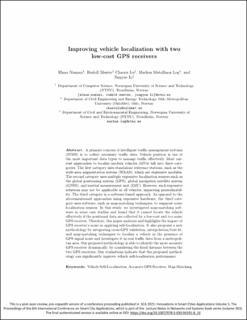| dc.description.abstract | A primary concern of intelligent traffic management systems (ITMS) is to collect necessary traffic data. Vehicle position is one of the most important data types to manage traffic effectively. Most current approaches to localize modern vehicles (MVs) fall into three categories. The first category uses standalone reference stations, such as the wide-area augmentation system (WAAS), which are expensive modules. The second category uses multiple expensive localization sensors such as the global positioning system (GPS), global navigation satellite system (GNSS), and inertial measurement unit (IMU). However, such expensive solutions may not be applicable in all vehicles, impacting generalizability. The third category is a software-based approach. As opposed to the abovementioned approaches using expensive hardware, the third category uses software, such as map-matching techniques, to augment noisy localization sensors. In this study, we investigated map-matching software in some case studies and found that it cannot locate the vehicle effectively if the positional data are collected by a low-cost and too noisy GPS receiver. Therefore, this paper analyzes and highlights the impact of GPS receiver’s noise in applying self-localization. It also proposes a new methodology by integrating cross-GPS validation, interpolation/best fit, and map-matching techniques to localize a vehicle in the presence of GPS signal noise and investigate it in real traffic data from a metropolitan area. Our proposed methodology is able to identify the more accurate GPS receiver dynamically, by considering the fixed distance between the two GPS receivers. Our evaluations indicate that the proposed methodology can significantly improve vehicle self-localization performance. | en_US |
